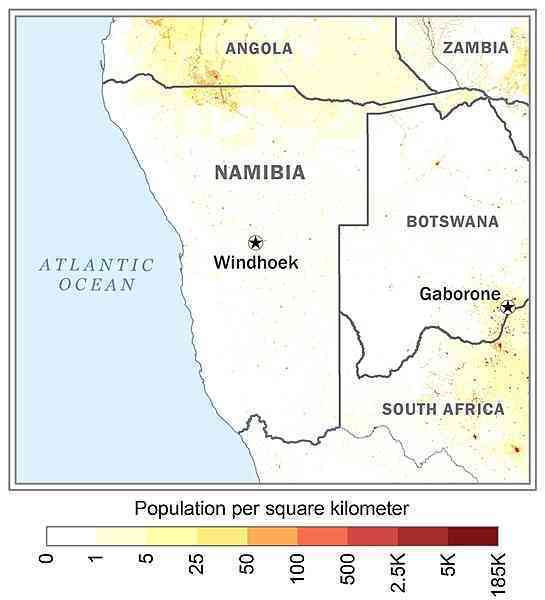
2,777,232 (2023 est.)
noun: Namibian(s)
adjective: Namibian
Ovambo 50%, Kavangos 9%, Herero 7%, Damara 7%, mixed European and African ancestry 6.5%, European 6%, Nama 5%, Caprivian 4%, San 3%, Baster 2%, Tswana 0.5%
Oshiwambo languages 49.7%, Nama/Damara 11%, Kavango languages 10.4%, Afrikaans 9.4% (also a common language), Herero languages 9.2%, Zambezi languages 4.9%, English (official) 2.3%, other African languages 1.5%, other European languages 0.7%, other 1% (2016 est.)
note: Namibia has 13 recognized national languages, including 10 indigenous African languages and 3 European languages
Christian 97.5%, other 0.6% (includes Muslim, Baha'i, Jewish, Buddhist), unaffiliated 1.9% (2020 est.)
Planning officials view Namibia’s reduced population growth rate as sustainable based on the country’s economic growth over the past decade. Prior to independence in 1990, Namibia’s relatively small population grew at about 3% annually, but declining fertility and the impact of HIV/AIDS slowed this growth to 1.4% by 2011, rebounding to close to 2% by 2016. Namibia’s fertility rate has fallen over the last two decades – from about 4.5 children per woman in 1996 to 3.4 in 2016 and to 3 in 2022 – due to increased contraceptive use, higher educational attainment among women, and greater female participation in the labor force. The average age at first birth has stayed fairly constant, but the age at first marriage continues to increase, indicating a rising incidence of premarital childbearing.
The majority of Namibians are rural dwellers (about 55%) and live in the better-watered north and northeast parts of the country. Migration, historically male-dominated, generally flows from northern communal areas – non-agricultural lands where blacks were sequestered under the apartheid system – to agricultural, mining, and manufacturing centers in the center and south. After independence from South Africa, restrictions on internal movement eased, and rural-urban migration increased, bolstering urban growth.
Some Namibians – usually persons who are better-educated, more affluent, and from urban areas – continue to legally migrate to South Africa temporarily to visit family and friends and, much less frequently, to pursue tertiary education or better economic opportunities. Namibians concentrated along the country’s other borders make unauthorized visits to Angola, Zambia, Zimbabwe, or Botswana, to visit family and to trade agricultural goods. Few Namibians express interest in permanently settling in other countries; they prefer the safety of their homeland, have a strong national identity, and enjoy a well-supplied retail sector. Although Namibia is receptive to foreign investment and cross-border trade, intolerance toward non-citizens is widespread.
0-14 years: 34.38% (male 482,432/female 472,474)
15-64 years: 61.68% (male 834,001/female 878,865)
65 years and over: 3.94% (2023 est.) (male 46,235/female 63,225)
total dependency ratio: 67.3
youth dependency ratio: 60.6
elderly dependency ratio: 6.7
potential support ratio: 14.8 (2021 est.)
total: 22.5 years (2023 est.)
male: 21.8 years
female: 23.2 years
1.66% (2023 est.)
24.6 births/1,000 population (2023 est.)
8.1 deaths/1,000 population (2023 est.)
0 migrant(s)/1,000 population (2023 est.)
population density is very low, with the largest clustering found in the extreme north-central area along the border with Angola as shown in this 
urban population: 54.9% of total population (2023)
rate of urbanization: 3.64% annual rate of change (2020-25 est.)

477,000 WINDHOEK (capital) (2023)
at birth: 1.03 male(s)/female
0-14 years: 1.02 male(s)/female
15-64 years: 0.95 male(s)/female
65 years and over: 0.73 male(s)/female
total population: 0.97 male(s)/female (2023 est.)
21.6 years (2013 est.)
note: data represents median age at first birth among women 25-49
215 deaths/100,000 live births (2020 est.)
total: 28.7 deaths/1,000 live births (2023 est.)
male: 31.7 deaths/1,000 live births
female: 25.5 deaths/1,000 live births
total population: 63.7 years (2023 est.)
male: 62.1 years
female: 65.4 years
2.94 children born/woman (2023 est.)
1.45 (2023 est.)
56.1% (2013)
improved: urban: 98.9% of population
rural: 83.2% of population
total: 91.4% of population
unimproved: urban: 1.1% of population
rural: 16.8% of population
total: 8.6% of population (2020 est.)
8.9% of GDP (2020)
0.59 physicians/1,000 population (2018)
2.7 beds/1,000 population
improved: urban: 70.6% of population
rural: 23.6% of population
total: 48.1% of population
unimproved: urban: 29.4% of population
rural: 76.4% of population
total: 51.9% of population (2020 est.)
degree of risk: high (2023)
food or waterborne diseases: bacterial diarrhea, hepatitis A, and typhoid fever
vectorborne diseases: malaria, and sexually transmitted diseases: HIV/AIDS (2024)
water contact diseases: schistosomiasis
17.2% (2016)
total: 2.38 liters of pure alcohol (2019 est.)
beer: 1.37 liters of pure alcohol (2019 est.)
wine: 0.16 liters of pure alcohol (2019 est.)
spirits: 0.53 liters of pure alcohol (2019 est.)
other alcohols: 0.32 liters of pure alcohol (2019 est.)
total: 15.1% (2020 est.)
male: 24.2% (2020 est.)
female: 6% (2020 est.)
13.2% (2013)
33.3% (2023 est.)
9.6% of GDP (2021 est.)
definition: age 15 and over can read and write
total population: 92.3%
male: 90.6%
female: 92.3% (2021)
NOTE: The information regarding Namibia on this page is re-published from the 2024 World Fact Book of the United States Central Intelligence Agency and other sources. No claims are made regarding the accuracy of Namibia 2024 information contained here. All suggestions for corrections of any errors about Namibia 2024 should be addressed to the CIA or the source cited on each page.
This page was last modified 04 May 24, Copyright © 2024 ITA all rights reserved.